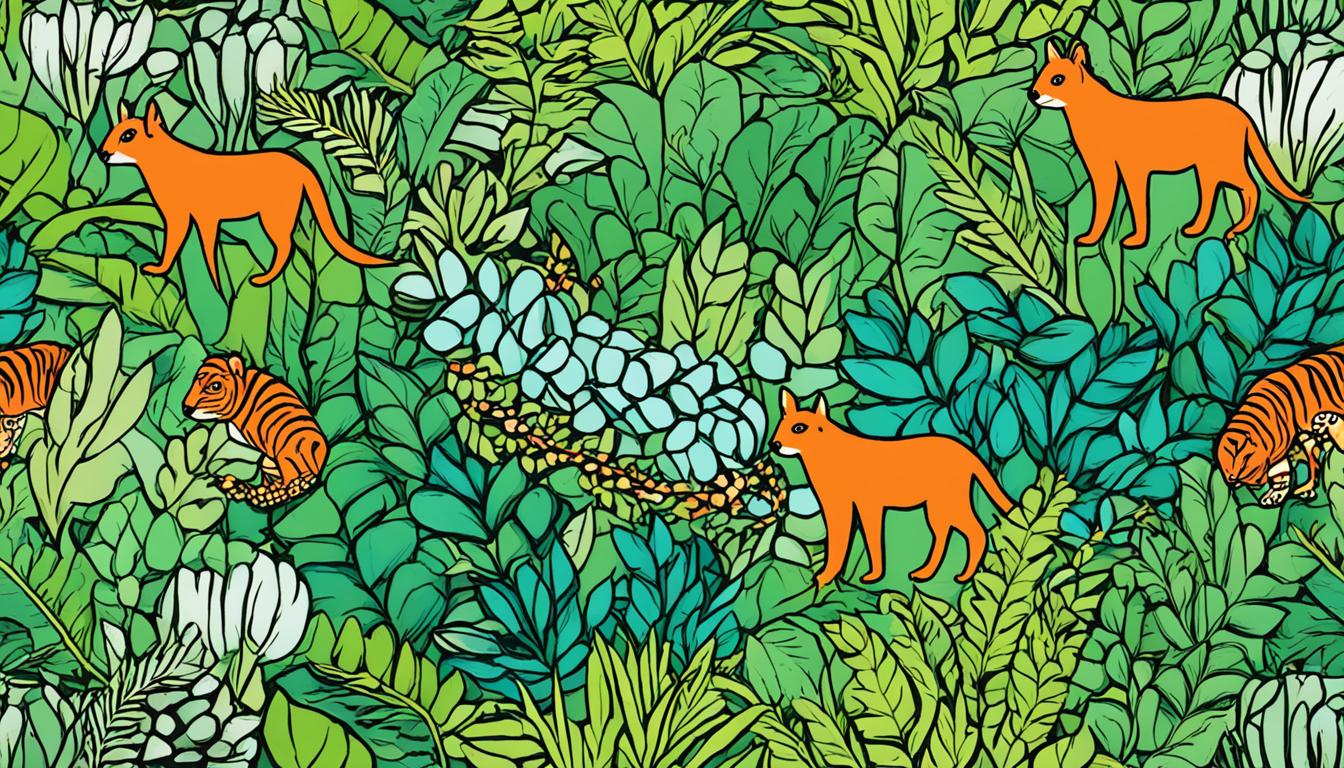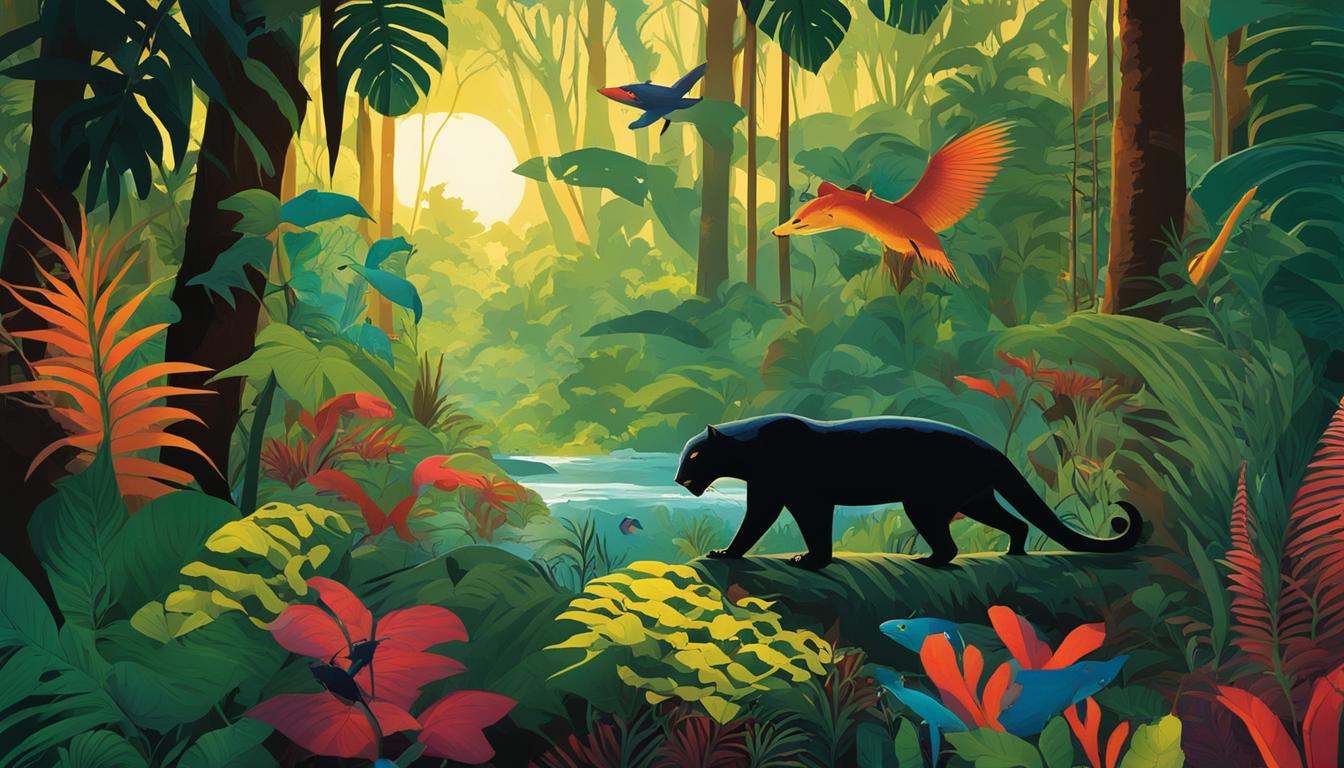Guinea-Bissau Biodiversity: Animal and Plant Species and What Is Under Threat
Did you know that Guinea-Bissau, a West-African country, is home to a staggering array of animal and plant species? From majestic predators like lions and leopards to primates such as western chimpanzees, Guinea-Bissau’s biodiversity is teeming with life. However, this rich diversity is under threat from environmental factors that endanger the delicate balance of its ecosystems.
Key Takeaways:
- Guinea-Bissau boasts a diverse range of animal and plant species.
- The country is home to predators like lions, leopards, and African wild dogs.
- Primates such as western chimpanzees are found in Guinea-Bissau.
- The tropical marine environment around the Bijagós Archipelago is rich in diverse sea life.
- Guinea-Bissau’s biodiversity is under threat from factors such as deforestation, overgrazing, overfishing, and climate change.
Status and Trends of Biodiversity in Guinea-Bissau.
Guinea-Bissau faces challenges in obtaining a precise overview of the status and trends of biodiversity due to a lack of comprehensive data on flora and fauna. However, significant efforts have been made in the establishment of protected areas, species inventories, and in-situ conservation activities to protect the country’s biodiversity and its unique ecosystems.
One of the key initiatives is the creation of protected areas, with six already established, covering 15% of the country’s territory. These protected areas, including the Archipel des Bijagos biosphere reserve, play a crucial role in preserving biodiversity and providing habitats for a wide range of plant and animal species. The government aims to increase the coverage of protected areas to 24% by creating additional terrestrial protected areas and corridors for fauna conservation.
In addition to protected areas, comprehensive species inventories have been carried out to document and understand the diversity of flora and fauna in Guinea-Bissau. These inventories provide valuable information for conservation efforts and serve as a baseline for monitoring changes in biodiversity over time.
Moreover, in-situ conservation activities, in collaboration with NGOs and local communities, have contributed to the success of the protected areas system. These activities involve the protection and management of biodiversity within its natural habitats, ensuring the long-term survival of endangered species and the preservation of genetic diversity.
Unfortunately, the political and military conflict in 1998 resulted in the loss of most gene banks located within the National Institute of Agrarian Research. This loss hampers the country’s ability to safeguard and conserve the genetic diversity of its plant species, highlighting the need for future initiatives to restore and preserve these important genetic resources.
Key Initiatives for Biodiversity Conservation in Guinea-Bissau
| Initiative | Description |
|---|---|
| Establishment of Protected Areas | Six protected areas covering 15% of the country’s territory; aims to increase coverage to 24% |
| Species Inventories | Comprehensive surveys to document and understand the diversity of flora and fauna |
| In-situ Conservation | Collaborative efforts with NGOs and local communities to protect and manage biodiversity within natural habitats |
| Loss of Gene Banks | Political/military conflict in 1998 resulted in the loss of most gene banks within the National Institute of Agrarian Research |
Overall, despite the challenges, Guinea-Bissau is making proactive efforts to conserve its biodiversity through protected areas, species inventories, and in-situ conservation activities. These initiatives are crucial for preserving the country’s unique ecosystems and ensuring the long-term sustainability of its rich biodiversity.
Impact of Agriculture on Biodiversity in Guinea-Bissau.
Agriculture plays a crucial role as the primary economic base in Guinea-Bissau. However, the current agrarian system has resulted in a significant loss of biodiversity and increased vulnerability to the effects of climate change. While the country possesses a vast agricultural potential, the actual cultivated surface remains relatively small.
The cultivation of various cereals such as rice, millet, maize, sorgho, and fonio dominates a large portion of the cultivated surface. Additionally, peanuts and tubers are cultivated to a lesser degree. Notably, a considerable proportion of rice production takes place in mangrove ecosystems, posing additional challenges to biodiversity conservation.
Zoogenetic resources, including cows, goats, swine, and sheep, are essential for the country’s agricultural sector. These resources provide crucial contributions to the local economy and food security. However, their sustainable management is crucial to mitigate further loss of biodiversity and preserve the delicate balance of the ecosystem.
Impact on Biodiversity
“The current agricultural practices, coupled with the expansion of cultivated surfaces, have had a detrimental impact on Guinea-Bissau’s biodiversity. The loss of natural habitats, such as pristine forests and mangroves, has disrupted the delicate ecological equilibrium, leading to a decline in species richness and genetic diversity.”
The loss of biodiversity resulting from the agrarian system has broader implications for ecosystem functioning and resilience. As the agricultural sector expands to meet the growing demands for food, there is a pressing need to strike a balance between agricultural production and the conservation of biodiversity.
| Agricultural Practices | Impact on Biodiversity |
|---|---|
| Expansion of cultivated surfaces | Loss of natural habitats and fragmentation |
| Monoculture cultivation | Reduction in habitat diversity and provision of limited resources for wildlife |
| Use of pesticides and fertilizers | Contamination of water bodies and negative effects on aquatic biodiversity |
Adapting Agricultural Practices for Conservation
Addressing the agricultural-related challenges to biodiversity conservation in Guinea-Bissau requires significant efforts in implementing sustainable agricultural practices and promoting ecosystem-friendly farming techniques. These measures can help mitigate the impacts of agriculture on biodiversity loss and contribute to climate change resilience.
- Encouraging diversified farming systems to reduce dependence on monoculture cultivation and enhance habitat diversity.
- Promoting organic farming practices that minimize the use of pesticides and fertilizers, protecting both terrestrial and aquatic biodiversity.
- Supporting the conservation and restoration of critical habitats, such as mangroves and forests, through sustainable land management strategies.
- Implementing agroforestry practices that combine tree planting with agricultural activities, enhancing biodiversity and promoting soil health.
By prioritizing sustainable agricultural practices, Guinea-Bissau can strike a balance between meeting the food production needs of its population and conserving its unique biodiversity. Integrated approaches that consider both agriculture and biodiversity conservation can contribute to the long-term resilience and sustainability of both ecosystems and communities.
Threats to Marine Biodiversity in Guinea-Bissau.
Guinea-Bissau’s waters are home to an abundance of fish resources, making them among the most well-stocked in the world. The marine ecosystems in this region boast a high level of diversity, supporting a wide variety of aquatic life. However, the marine biodiversity of Guinea-Bissau faces numerous threats that pose significant challenges to its sustainability and conservation.
One of the key threats to marine biodiversity in Guinea-Bissau is overfishing. The fisheries sector in the country is under constant pressure from excessive fishing efforts, which deplete fish populations and disrupt the balance of the marine ecosystem. Overfishing not only affects the targeted species but also has cascading effects on the entire food web.
Illegal fishing is another major concern. Some foreign fishing vessels, primarily targeting shrimp, operate in Guinea-Bissau’s territorial waters without proper authorization. This illegal fishing activity not only threatens the fish resources but also undermines the efforts to regulate and manage the fisheries sector.
“The industrial foreign fishing vessels, mainly targeting shrimp, often do not have legal rights to fish in Guinea-Bissau’s territorial waters.”
The smoking of fish, a traditional activity in the region, also poses a threat to marine biodiversity, particularly the delicate mangrove ecosystems. The smokehouses that process fish for consumption release harmful by-products that negatively impact the health of mangroves, leading to habitat degradation and loss of important coastal protection.
Despite the challenges, the fisheries sector plays a significant role in the national economy of Guinea-Bissau, contributing to the country’s budget and providing employment opportunities, with more women than men employed in this sector. However, it is critical to strike a balance between economic benefits and sustainable practices to ensure the long-term health and productivity of aquatic ecosystems.
Table 4: Impacts of Threats to Marine Biodiversity in Guinea-Bissau
| Threats | Impacts |
|---|---|
| Overfishing | Depletion of fish populations, disruption of the marine food web |
| Illegal fishing | Undermines fisheries management, threatens fish resources |
| Smoking of fish | Habitat degradation and loss of mangrove ecosystems |
Protecting and conserving marine biodiversity in Guinea-Bissau requires effective fisheries management, enforcement of fishing regulations, and the promotion of sustainable fishing practices. Implementing measures to address the threats to marine ecosystems is crucial for ensuring the preservation of fish resources and maintaining the overall health and resilience of the marine environment.
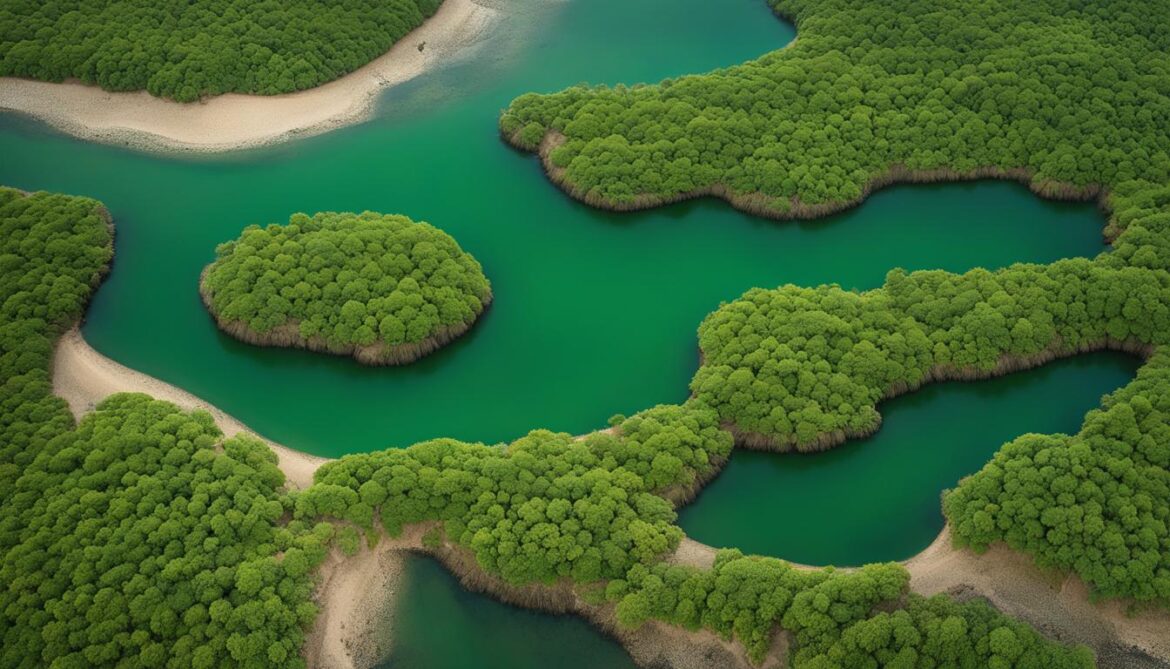
Image: Mangrove ecosystems play a vital role in coastal protection and support a diverse range of marine life.
Degradation of Terrestrial Ecosystems in Guinea-Bissau.
Terrestrial ecosystems in Guinea-Bissau are under threat from various human-induced pressures, including deforestation, the exploitation of forest resources, poaching, bushfires, and mining activities. Between 1990 and 2007, the country experienced significant deforestation rates across different types of forests, leading to the loss of valuable habitats and biodiversity. However, one bright spot amidst this degradation is the remaining mangrove forests, which are almost intact. Guinea-Bissau is one of the countries with the highest rates of mangrove coverage globally, providing critical ecosystem services and supporting a diverse range of flora and fauna.
The potential of forest legislation to mitigate these issues was recognized in 2011 when the legislation was updated. However, effective implementation is key to address the challenges faced by Guinea-Bissau’s terrestrial ecosystems. This includes rational resource exploitation and reforestation efforts to restore damaged areas. Some progress has already been made with the classification of community forests, contributing to conservation initiatives. Additionally, the forest carbon stocks in Guinea-Bissau have the potential to contribute to the Clean Development Mechanism under the Kyoto Protocol, further emphasizing the importance of protecting and restoring these valuable ecosystems.
To gain a better understanding of the degradation of terrestrial ecosystems, a detailed analysis is presented in the table below:
| Possible Causes of Degradation | Impacts |
|---|---|
| Deforestation | Loss of habitat, reduced biodiversity, increased risk of soil erosion |
| Exploitation of forest resources | Loss of valuable timber species, disruption of ecological balance |
| Poaching | Decline in wildlife populations, disruption of ecological processes |
| Bushfires | Loss of vegetation, destruction of habitats, soil degradation |
| Mining activities | Habitat destruction, water pollution, soil erosion |
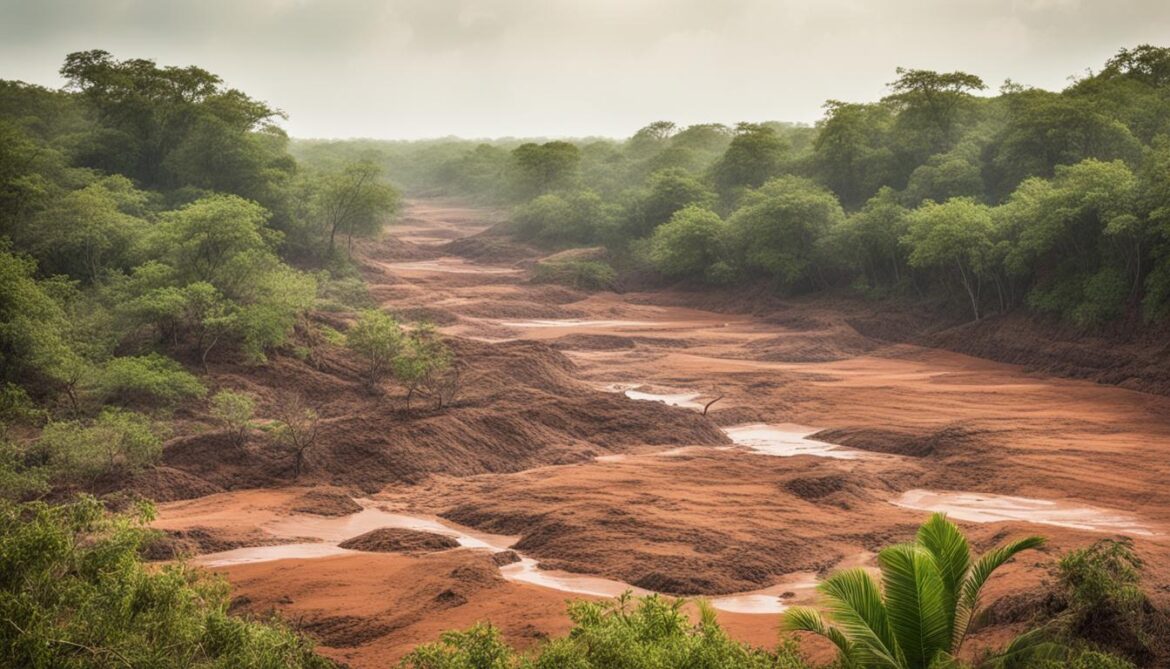
It is crucial to address these issues and prioritize the conservation and restoration of Guinea-Bissau’s terrestrial ecosystems. By implementing sustainable practices, enforcing forest legislation, and promoting reforestation efforts, we can work towards preserving the valuable ecosystems and protecting the biodiversity that depends on them. Collaboration between government agencies, NGOs, and local communities is vital for effective conservation and restoration actions.
Rare and Endangered Species in Guinea-Bissau.
Guinea-Bissau is home to several rare and endangered species, including the manatee, hippopotamus, crocodile, marine turtle, various species of monkeys, and buffalo. These majestic creatures contribute to the country’s rich biodiversity and natural heritage. However, their existence is threatened by various factors, such as habitat loss, hunting practices, and illegal exploitation. It is essential to prioritize conservation efforts to protect and preserve these vulnerable species for future generations.
The manatee, a gentle aquatic mammal, faces habitat destruction due to coastal development and pollution. Similarly, the hippopotamus and crocodile, iconic African species, suffer from habitat loss and degradation caused by human activities. Marine turtles, including the critically endangered leatherback turtle, are threatened by pollution, entanglement in fishing nets, and the destruction of nesting sites.
The diverse range of monkey species in Guinea-Bissau, such as chimpanzees, baboons, and guenons, are under pressure from deforestation, illegal pet trade, and bushmeat hunting. These intelligent and charismatic primates play vital roles in forest ecosystems and require immediate conservation action. Additionally, the majestic buffalo population is declining due to habitat fragmentation and illegal hunting for bushmeat and trophies.

Conservation efforts in Guinea-Bissau must focus on protecting and restoring the habitats of these rare and endangered species. This involves implementing effective measures to prevent habitat destruction and mitigate human-wildlife conflicts. Collaborative initiatives between local communities, government agencies, and conservation organizations play a crucial role in safeguarding the future of these iconic animals.
By raising awareness, promoting sustainable practices, and enforcing wildlife protection laws, Guinea-Bissau can ensure the long-term survival of its precious and vulnerable species. Preserving the biodiversity of Guinea-Bissau is not only important for the ecological balance but also for the cultural and economic heritage of the country.
Pressures on Biodiversity and Drivers of Change.
Guinea-Bissau faces significant challenges when it comes to preserving its rich biodiversity. The country is plagued by various forms of illegal exploitation, including poaching, habitat degradation, and unregulated trade. These activities have a detrimental impact on the diverse species and fragile ecosystems of Guinea-Bissau.
One of the major contributors to biodiversity loss is illegal exploitation. Through illicit activities, valuable resources such as timber and wildlife are taken from their natural habitats without proper regulation or management. This not only threatens the survival of key species but also disrupts the delicate balance of ecosystems.
Poaching is another pressing issue. The relentless hunting of animals for their body parts, skins, or meat poses a severe threat to endangered species and disrupts their breeding patterns. It is a destructive practice that leads to a decline in population numbers and disrupts the natural dynamics of the animal kingdom.
Habitat degradation is a consequence of human activities such as deforestation, mining, and traditional agricultural practices. These practices result in the loss of crucial habitats for many species, driving them towards endangerment or extinction. Furthermore, bushfires exacerbate the problem by destroying vast areas of vegetation, leading to soil erosion and degradation.

The unregulated trade of wildlife, both within the country and across borders, plays a significant role in biodiversity loss. It contributes to the decline of vulnerable species by disrupting their natural populations and ecosystems. Additionally, the irrational exploitation of valuable wood species further exacerbates the problem of habitat degradation.
Perhaps one of the underlying factors contributing to the pressures on biodiversity in Guinea-Bissau is poverty. High levels of poverty in the country drive unsustainable resource use as communities rely on natural resources for their livelihoods. In the pursuit of basic needs, people engage in activities that further threaten biodiversity, perpetuating a destructive cycle.
Impacts on Terrestrial Ecosystems
“Human activities, such as traditional agricultural practices, mining, and bushfires, have particularly damaging effects on terrestrial ecosystems in Guinea-Bissau.”
Traditional agricultural practices, although essential for food production, often involve clearing large areas of land, leading to deforestation and the loss of biodiversity-rich habitats. Mining activities, including both legal and illegal operations, ravage the land, polluting water sources and destroying natural habitats.
Bushfires, sometimes started intentionally for land clearance, can quickly spread out of control, devastating vast areas of vegetation. This not only destroys vital habitats but also accelerates soil erosion and degradation, further undermining the resilience and health of terrestrial ecosystems.
| Pressures on Biodiversity | Drivers of Change |
|---|---|
| Illegal exploitation | Poverty |
| Poaching | Unregulated trade |
| Habitat degradation |
Measures to Enhance Implementation of Biodiversity Conservation in Guinea-Bissau.
Guinea-Bissau has taken significant steps towards the conservation of its rich biodiversity through the implementation of the National Biodiversity Strategy and Action Plan (NBSAP). The NBSAP serves as a comprehensive framework for biodiversity planning and management, guiding the country’s conservation efforts. Recognizing the importance of continuous improvement, Guinea-Bissau is actively working to update the NBSAP to include linkages between biodiversity conservation and poverty reduction.
Efforts are underway to integrate biodiversity considerations into sectoral and cross-sectoral frameworks, ensuring that all aspects of development take into account the protection and sustainable use of biological resources. By incorporating biodiversity into policies and plans related to agriculture, fisheries, forestry, and tourism, Guinea-Bissau aims to create a holistic approach to conservation.
In addition to policy integration, the country is developing mechanisms for the payment of environmental services to incentivize the conservation and sustainable use of biodiversity. This includes exploring opportunities to participate in carbon credit markets and other market-based solutions to promote biodiversity-friendly practices.
Guinea-Bissau has also implemented legislation and strategies to support the effective implementation of biodiversity conservation. Environmental impact assessment laws provide a framework for assessing the potential impacts of development projects on biodiversity, ensuring that decisions are made with full consideration of ecological concerns. Forest laws and environment codes further bolster the legal framework for biodiversity protection.
While Guinea-Bissau’s commitment to biodiversity conservation is commendable, the country faces challenges in implementation due to financial constraints and a lack of human resources. Adequate funding and capacity-building initiatives are crucial to overcome these hurdles and ensure the effective management of protected areas and other conservation measures.
The coordination mechanism among various stakeholders is also essential for successful biodiversity conservation. Collaboration between government agencies, non-governmental organizations, local communities, and international partners is key to achieving shared conservation goals and fostering sustainable development.
By strengthening the NBSAP, improving policy integration, ensuring adequate resources, and fostering coordination among stakeholders, Guinea-Bissau aims to enhance the implementation of biodiversity conservation measures and safeguard its unique natural heritage for future generations.
| Measures | Description |
|---|---|
| NBSAP | The National Biodiversity Strategy and Action Plan provides a comprehensive framework for biodiversity planning and management. |
| Biodiversity planning | Efforts to integrate biodiversity considerations into sectoral and cross-sectoral frameworks. |
| Protected areas management | The effective management of protected areas to ensure the conservation of biodiversity. |
| Coordination mechanism | The establishment of collaboration mechanisms between stakeholders for effective biodiversity conservation. |
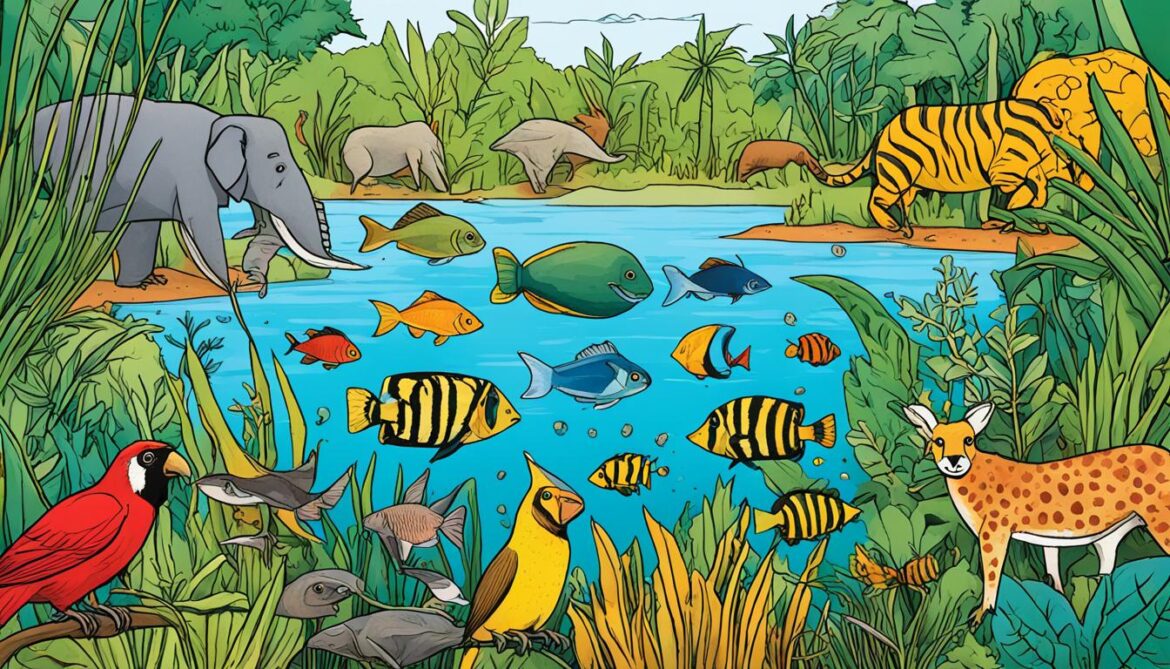
Actions Taken to Achieve the 2020 Aichi Biodiversity Targets.
In line with the implementation of the National Biodiversity Strategy and Action Plan (NBSAP), Guinea-Bissau has recognized the significance of updating and revising it to align with the 2020 Aichi Biodiversity Targets. Although specific actions taken to achieve these targets are not currently available, the country considers the current NBSAP as an effective tool for CBD (Convention on Biological Diversity) implementation.
To effectively implement the Aichi Targets, capacity development for biodiversity planning and the application of research are critical. Building the necessary knowledge and skills within the relevant institutions and stakeholders will enable Guinea-Bissau to successfully address the objectives set forth in the Aichi Biodiversity Targets. By enhancing capacity development initiatives, including training programs and knowledge-sharing platforms, the country can ensure the effective implementation of conservation measures and strategies.
“Capacity development is key to addressing the challenges of biodiversity conservation and achieving the Aichi Biodiversity Targets. By empowering individuals and institutions with the necessary skills, knowledge, and resources, we can build a sustainable future for Guinea-Bissau’s rich biodiversity.” – [Insert Name], Biodiversity Expert
Actions for Implementation of NBSAP
The implementation of the NBSAP in Guinea-Bissau involves a series of strategic actions aimed at conserving and sustainably managing the country’s biodiversity. These actions include:
- Strengthening institutional frameworks and governance mechanisms to support biodiversity conservation and management.
- Developing and implementing policies and legislation to protect and regulate biodiversity, including the establishment of protected areas and the promotion of sustainable use of natural resources.
- Enhancing research and monitoring efforts to improve understanding of Guinea-Bissau’s biodiversity, its status, and the threats it faces.
- Engaging local communities and indigenous peoples in biodiversity conservation and ensuring their active participation in decision-making processes.
- Building partnerships and collaborations with national, regional, and international organizations to leverage resources, share best practices, and enhance capacity development.
By implementing these actions, Guinea-Bissau can make significant progress towards achieving the Aichi Biodiversity Targets and ensuring the long-term conservation of its unique ecosystems and species.
Overview of Guinea-Bissau’s Progress Towards Aichi Biodiversity Targets
| Aichi Biodiversity Target | Status |
|---|---|
| Target 1: Awareness and Understanding | Ongoing efforts to raise awareness about biodiversity among local communities and stakeholders. |
| Target 2: Mainstreaming Biodiversity | Integration of biodiversity considerations into sectoral and cross-sectoral frameworks, including sustainable development plans. |
| Target 3: Incentives and Positive Measures | Identification and implementation of mechanisms for payment for environmental services and participation in carbon credit markets. |
| Target 4: Sustainable Use | Promotion of sustainable use practices and regulation of extractive industries to minimize negative impacts on biodiversity. |
| Target 5: Status of Ecosystems | Ongoing assessments of ecosystem health and spatial planning to support the conservation and restoration of critical habitats. |
| Target 6: Sustainable Agriculture | Encouragement of sustainable agricultural practices that maintain soil fertility, minimize chemical use, and protect biodiversity. |
| Target 7: Forests and Climate Change | Strengthening forest management practices and leveraging forest carbon stocks for climate change mitigation. |
| Target 8: Pollution | Development and enforcement of regulations to minimize pollution and waste generation. |
| Target 9: Invasive Species | Monitoring and management of invasive species to minimize their impact on native biodiversity. |
| Target 10: Sustainable Tourism | Promotion of sustainable tourism practices that contribute to biodiversity conservation and support local communities. |
As Guinea-Bissau continues its efforts towards achieving the Aichi Biodiversity Targets, the country remains committed to balancing conservation needs with sustainable development, ensuring the protection of its unique natural heritage for future generations.

Support Mechanisms for Biodiversity Conservation in Guinea-Bissau.
Guinea-Bissau has taken significant steps to establish support mechanisms for biodiversity conservation. The country has enacted legislation and policies focused on protecting its forests, protected areas, and the environment. These measures aim to ensure the preservation of Guinea-Bissau’s unique biodiversity.
One notable initiative is the establishment of co-management arrangements with local communities for protected areas and marine protected areas. This approach promotes collaboration and empowers local stakeholders in the preservation and management of these critical habitats.
Furthermore, efforts are underway to enhance the capacity of institutions responsible for protected areas through sustainable financing mechanisms. This includes exploring innovative funding models that prioritize long-term sustainability and enable effective conservation efforts.
However, while progress has been made, there is a need for improved coordination and monitoring across different sectors and stakeholders. By strengthening coordination mechanisms, Guinea-Bissau can better integrate biodiversity conservation efforts into various sectors, ensuring a comprehensive and holistic approach to preservation.
Additionally, mainstreaming biodiversity conservation into national development plans and policies is crucial. By embedding biodiversity considerations into various sectors, such as agriculture, fisheries, and infrastructure, Guinea-Bissau can maximize the impact of conservation measures and create a more sustainable future.
Key Support Mechanisms for Biodiversity Conservation in Guinea-Bissau:
- Legislation and policies focused on forests, protected areas, and the environment
- Co-management arrangements with local communities for protected areas and marine protected areas
- Efforts to enhance the capacity of protected area institutions through sustainable financing mechanisms
- Improved coordination and monitoring across sectors and stakeholders
- Mainstreaming biodiversity conservation into national development plans and policies
By implementing these support mechanisms, Guinea-Bissau can further strengthen its commitment to biodiversity conservation and ensure the long-term preservation of its rich natural heritage.
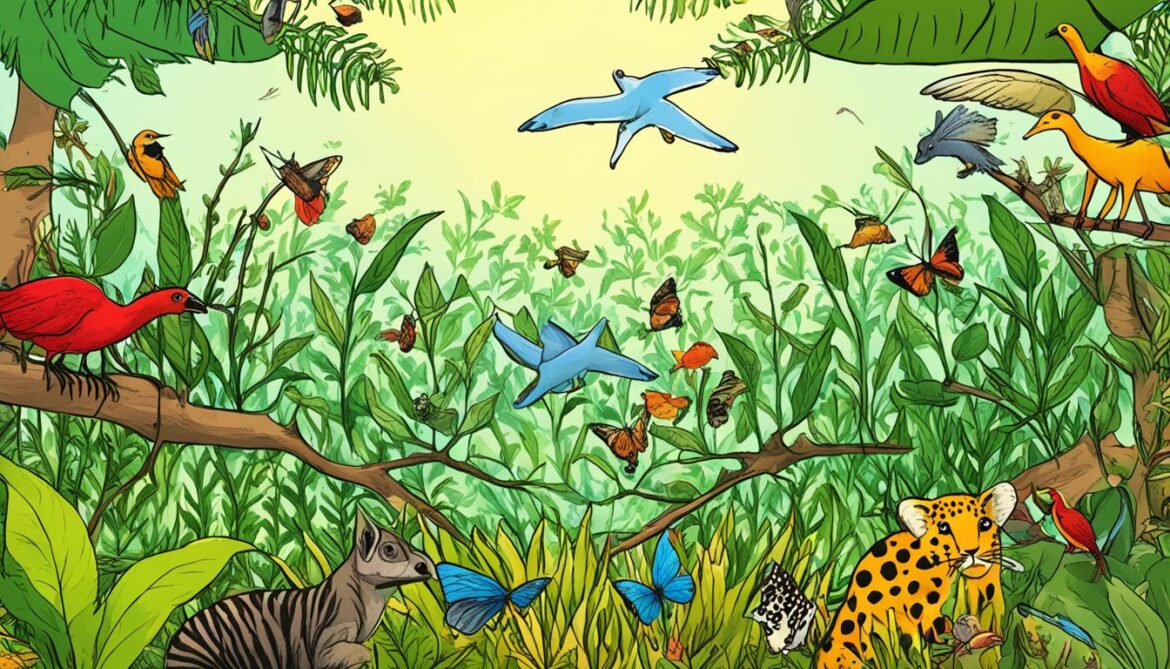
Conclusion.
Guinea-Bissau’s rich biodiversity is a crucial resource that contributes to sustainable development and provides vital ecological services. However, the country faces significant challenges in preserving its diverse species and protecting their natural habitats. To safeguard Guinea-Bissau’s unique ecosystems, it is essential to prioritize conservation efforts, including the establishment of protected areas and the adoption of sustainable agricultural practices.
By creating protected areas, Guinea-Bissau can provide safe havens for its endangered wildlife and plant species. These protected areas also play a vital role in promoting environmental protection and mitigating the impacts of human activities on natural habitats. Additionally, the implementation of sustainable agricultural practices is crucial to prevent further loss of biodiversity and ensure the long-term viability of the agrarian system.
Continued collaboration and support from the international community are pivotal for the successful conservation of Guinea-Bissau’s biodiversity and the promotion of environmental protection. By working together, we can help Guinea-Bissau overcome the challenges it faces and support its efforts in achieving sustainable development while preserving its valuable natural heritage for future generations.




